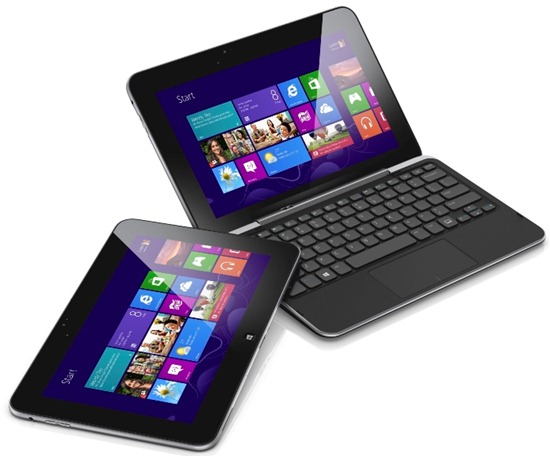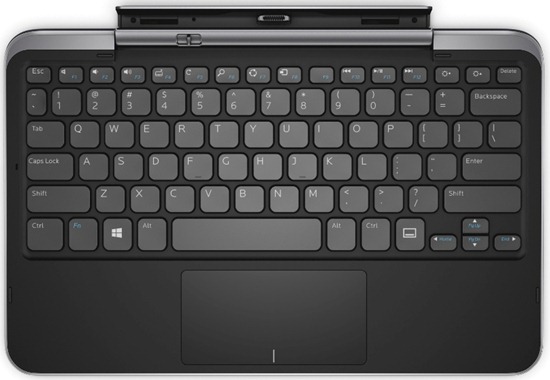Many of you have seen a couple of my previous posts about Dell’s new XPS 10 Windows RT tablet. Since we started shipping it last month, I thought it was worth sharing my experience after getting some hands-on time over the holiday break. In my time with it, I’d say the XPS 10 tablet is a really good balance between work and play.
Windows RT is the OS that runs on ARM-based processors and is optimized for thin and sleek devices with long battery life. It is designed to run some new or “modern” core Windows 8 built-in apps like Mail, Messaging, Music, Video, etc. as well as apps you download from the Windows Store. Soon, I’ll write another post regarding the differences between Windows 8 and Windows RT. For the time being, take a look at Microsoft’s FAQ on Windows RT if you’re interested. In my experience, if you are familiar with the Windows 8 touch interface, you’ll feel right at home in Windows RT. Among other things, that means you can expect the a great touch experience across the board.
The XPS 10 is powered by Qualcomm’s ARM-based Snapdragon dual-core 1.5 GHz processor. In my experience with it, performance was snappy across the board. Whether I used the tablet to to play games like Angry Birds Star Wars, Chimpact or Reckless Racing Ultimate, or to play music, browse pictures, stream movies, or using the Office apps like Word for Windows RT, it handled things smoothly. Besides providing plenty of horsepower, the Snapdragon processor is also pretty impressive in terms of power efficiency. In my time using the tablet, I’ve been getting more than 9 hours between charges, even when I’m doing more intensive things like streaming movies. The XPS 10 supports two storage configs—one with 32GB and the other with 64GB. I tested the 32GB version.
Note: Click on any of the images below to see larger versions. You can also check out the XPS 10 Windows RT tablet album on Dell’s Google+ page to see additional images.
Speaking of streaming movies, like I mentioned, performance in Netflix was smooth. I mean that in terms of the video playback itself and the great Wi-Fi performance that our dual-band solution provides. After taking a short time to queue the Mirror Mirror, playback was smooth and looked great on the 1366×768 IPS display. Besides overall image quality, the IPS display also means an expanded viewing angle, so movies and images look great even if you’re looking at it from an angle. I was able to use the scroll bar to easily find the creepy puppet scene by looking at the thumbnails. It resumed playback at the new location quickly as well. My experience with Hulu+ was similar, as was viewing movie trailers in the Microsoft Video app.
Solid overall performance is important, but that in itself is not something new in the tablet landscape. Using a tablet to get work done is something that you typically hear less about. And for the XPS 10, we put just as much emphasis on the productivity side of things. The obvious place to start is for Office RT. Specifically, all XPS 10 tablets come bundled with Office Home and Student 2013 RT. That package includes RT versions of Word, Excel PowerPoint and OneNote. It is set up to save all your documents to Microsoft’s SkyDrive. In my experience, the Office RT apps worked well, whether I was creating new documents or accessing ones I had created on my laptop or on my home desktop. Office RT makes it easy to go beyond viewing documents to making edits or creating documents on the fly. I’ve been using SkyDrive since the early days and it works well. In my view, two things set it apart from competing options from other cloud options from big companies like Apple and Google 1) SkyDrive offers seamless integration with laptops and desktops running Windows 7 or Windows 8 and 2) Mobile device capability – I think it’s awesome that there’s a SkyDrive client for both Android and iOS. Beyond seamless Office RT + SkyDrive, the XPS 10 offers dual array mics and stereo sound for voice or video calls. And the front-facing 2 megapixel HD camera is designed to support 720p video at 30 frames per second.
Another area you don’t tend to hear about much in terms of tablets is security, and that’s something that is critically important to many companies today. To that end, the XPS 10 has firmware TPM and default BitLocker encryption capability built in. Device manageability is also important, and that’s why the XPS 10 includes cloud-based mobile device management features via InTune and other IT-friendly features like Exchange ActiveSync.
Hardware build quality is solid without feeling heavy. In my experience, at 628 grams (about 1.4 pounds) the XPS 10 is light, balanced and comfortable to hold either in portrait or landscape mode. Those of you who are familiar with our XPS 13 will notice similarities in terms of attention to details. The edge-to-edge display is an obvious thing. The soft-touch painted plastic on the back provides a no slip sort of grip and reminds me of the smooth feel of the palm rest area of the XPS 13. The solid border around the display also gives the things like the power button or the volume up/ down buttons a solid feel, and the their placement feels natural as well. The microSD card slot supports SDXC cards up to 64GB of additional storage capacity and is concealed by a seamless cover. I found myself using the physical buttons by feel in no time and really liked the seamlessness of the design. Another nice touch is that the micro-USB port on the bottom supports a trickle charging option so you can charge the XPS 10 using chargers you may already have for your smartphone or other tablet like the Nexus 7.
Though I did not have the keyboard for testing, I know our development teams put a lot of effort into making that part right, especially in terms of design stability and capability. The tablet snaps securely into the keyboard dock and can adjusted to different viewing angles easily. Our teams worked to provide a different tablet experience by making video conference calls easy overall, and this is especially true when using the XPS 10 with the keyboard dock. The clamshell design (see image below) means you can close the tablet when docked so that the keyboard doubles as a screen protector when you are on the move. The keyboard also includes a second battery that’s the same size as the one in the tablet. That means when it’s docked, you will extend battery life several more hours. The keyboard dock also includes 2 USB 2.0 ports for peripherals like a flash drive, keyboard or mouse, or that you can use to charge your cellphone or other device. The larger dock speakers work in conjunction with the tablet speakers for clear Skype calls or video chats and conference calls. The dock also has a mini-HDMI port for connecting to an external display. I’ll look to do another post when I can get my hands on a keyboard dock.
If you’re curious about other hardware features, check out the XPS 10 Tech Specs link. Below is a short video that highlights some of the XPS 10 tablet’s features. I welcome your questions below or via @LionelatDell on Twitter.



